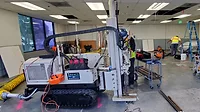First-ever solid electron donor material found to improve chlorinated solvent treatments in bio-barriers
A leading approach for treating chlorinated solvents in groundwater is rooted in natural biology: Enhanced reductive dechlorination (ERD).
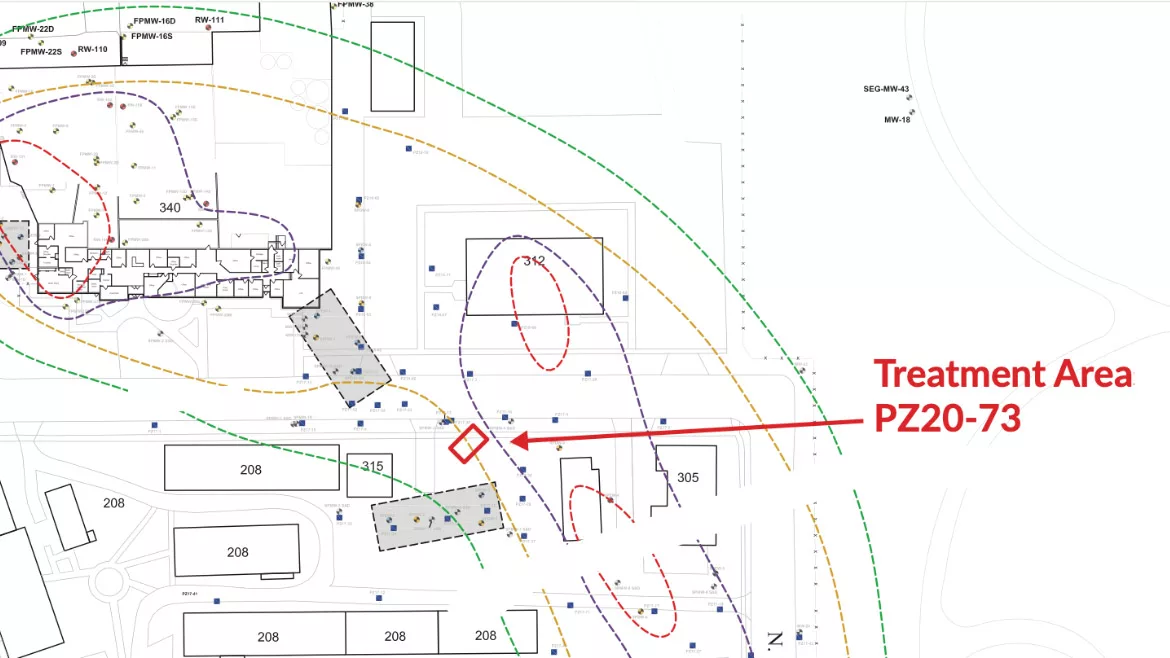
At thousands of sites worldwide, chlorinated solvent spills have contaminated groundwater, forming plumes migrating offsite to impact adjacent properties, threaten drinking water wells, enter streams, or cast-off toxic vapors intruding neighborhood homes. These sites range from dry cleaners and industrial manufacturers to landfills and Superfund sites.
The treatment objective at sites impacted with chlorinated volatile organic compounds (CVOCs) often involves stopping or preventing a CVOC plume from moving offsite. However, there are limited practical, cost-effective remedies that have achieved this goal over the long term.
A new solid, colloidal organic material (AquiFixTM) has been developed to address this need, markedly improving remedial outcomes for in situ (i.e., in place) bio-barrier treatments designed to stop migrating CVOC plumes.
What is Enhanced Reductive Dechlorination?
A leading approach for treating chlorinated solvents in groundwater is rooted in biology. Enhanced reductive dechlorination (ERD) involves using naturally occurring bacteria to break down the chlorinated solvents into less harmful compounds.
Under the right conditions, dechlorinating bacteria utilize the contaminants much like humans use oxygen and convert them into harmless byproducts such as ethene. Following a stepwise reaction sequence, hydrogen atoms on the CVOC molecules are replaced with chlorine atoms (Figure 1).

Although reductive dechlorination of CVOCs is a natural process, most plumes do not contain enough available carbon that can be fermented to hydrogen, stalling the process. This stall is reflected in untreated, naturally degrading PCE drycleaning solvent plumes, which usually contain one or more daughter products like trichloroethene (TCE), cis-1,2-dichloroethene (cis-DCE), or vinyl chloride (VC). In most cases, there is sufficient native carbon in the aquifer to take only a step or two down the reductive dechlorination pathway. Going further requires intervention.
ERD entails injecting fermentable products (a.k.a. electron donors) into the contaminated aquifer that may be converted to a hydrogen source to facilitate CVOC degradation by native or injected bacteria. Mixtures or ‘consortia’ of bacteria containing Dehalococcoides spp. are typically injected with the electron donors to ensure robust populations of active dechlorinating microbes are present at the beginning of ERD treatments, leading to improved performance.
ERD is well established, having been used on thousands of sites to treat CVOCs in groundwater since the 1990s. The in situ approach is relatively easy to apply, low cost, and causes minimal site disruption, features appealing to remediation specialists and property owners alike.
Incomplete Treatment: Addressing the Shortcomings of ERD in Bio-Barriers
While ERD has decades of proven effectiveness for remediating CVOCs, it has often not been effective in barrier treatments intended to stop migrating plumes. This lack of performance is chiefly due to the insufficient contact time between the contaminants and the hydrogen supply that allows microbes to degrade CVOCs in a barrier fully. A tell-tale sign of incomplete bio-barrier treatments is an increase of daughter CVOCs downgradient of the barrier, usually an undesirable outcome (Figure 2).
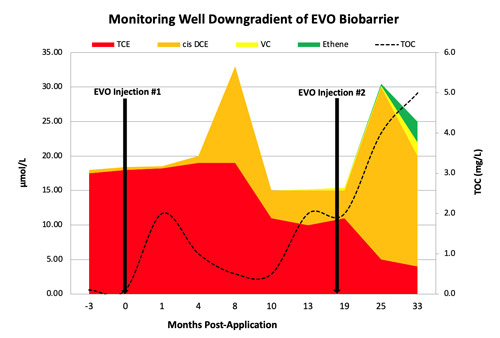
More recently, attention was turned toward optimizing these sorption-ERD treatments for CVOCs, with a primary goal of increasing the treatment longevity after a single injection. A material that can be applied with CAC under low injection pressures while achieving excellent distribution was also a priority.
Following extensive development and lab-scale testing, a novel solid amendment that improves hydrogen release efficiency and longevity in sorption-ERD treatments was developed, exhibiting the following features:
- Solid, colloidal amendment comprising 0.5-micron-sized organic particles,
- Blended with fast-release components and micronutrients like vitamin B-12,
- Chemically compatible and co-applied with CAC, and
- Provides a stable, long-lasting hydrogen supply designed for sustaining ERD treatment of CVOCs for 10+ years.
After lab-scale testing showing impressive results, a field pilot test was planned for the new amendment.
AquiFix Field Pilot Test in Extreme CVOC Mass Flux Plume
The 26-month long pilot test was conducted in a large CVOC plume, originating from a manufacturing and distribution facility in the Midwest (Figure 3). Spills of PCE and TCE created a groundwater CVOC plume migrating through glacial outwash (i.e., a prominent esker) and extending thousands of feet downgradient from the site.
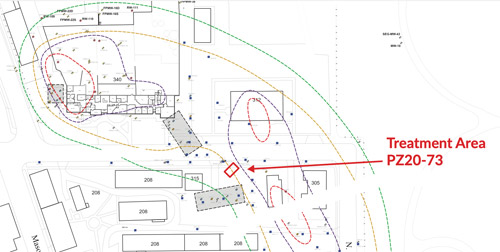 Figure 3. Map showing pilot test treatment area PZ-20-73 within the large CVOC plume. Image from REGENESIS.High CVOC concentrations of more than 60,000 micrograms per liter (µg/L) of TCE and cis-DCE were measured in the pilot study area well (PZ20-73D), which also boasted a groundwater seepage velocity of 600 feet per year.
Figure 3. Map showing pilot test treatment area PZ-20-73 within the large CVOC plume. Image from REGENESIS.High CVOC concentrations of more than 60,000 micrograms per liter (µg/L) of TCE and cis-DCE were measured in the pilot study area well (PZ20-73D), which also boasted a groundwater seepage velocity of 600 feet per year. The extreme mass flux environment (6,400 mg/m2/day), in the top tier of CVOC plumes, created a challenging test case for a sorption-ERD barrier treatment using CAC and AquiFix. These materials were injected under low pressure (averaging less than 20 pounds per square inch) into a short barrier segment spanning the extreme mass flux zone, along with a small volume of Bio-Dechlor Inoculum (BDI), a microbial consortium containing DHC (Figure 4).
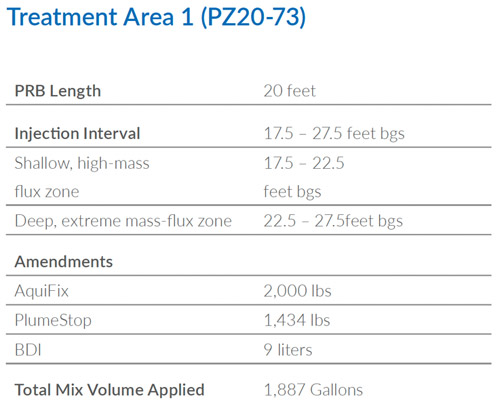
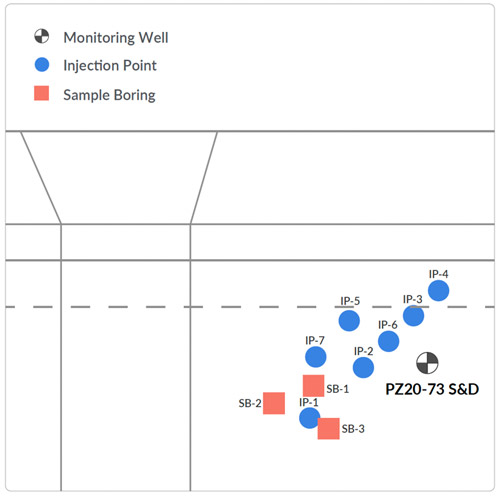 Figure 4. Pilot test map of treatment area and injection details. Image from REGENESIS.
Figure 4. Pilot test map of treatment area and injection details. Image from REGENESIS.Pilot Test Results
The pilot test shows the PlumeStop + AquiFix bio-barrier to be highly effective in treating CVOCs in an extreme mass flux environment, based on the following results:
- Total CVOC concentrations in groundwater were reduced by 97% in one month and further reduced by >99% after two years of monitoring (Figure 5).
- High concentrations of ethene were sustained during the second year of post-injection monitoring. After two years, ethene concentrations are seven times higher than all CVOCs combined, indicating CVOCs are being fully converted to non-toxic end products within the barrier, as designed (Figure 6).
- Total organic carbon (TOC) concentrations were elevated above 1,000 mg/L immediately following the injection, remaining relatively consistent between 10 and 100 mg/L over the last three monitoring events (Figure 5).
- DHC populations have been sustained at greater than 104 cells/mL, a benchmark concentration indicating healthy ERD activity. Vinyl chloride reductase (VCR – a functional gene) concentrations have also been sustained at high levels (Figure 7).
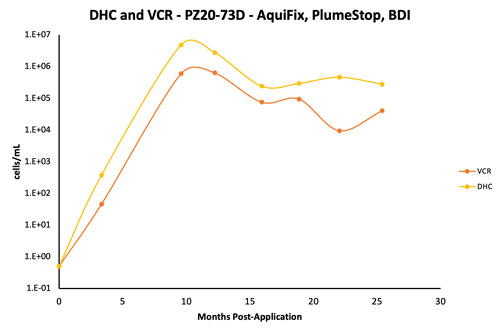 Figure 5. Chlorinated ethene and ethene concentrations at PZ20-73D in AquiFix, PlumeStop, BDI pilot test barrier. Image from REGENESIS.
Figure 5. Chlorinated ethene and ethene concentrations at PZ20-73D in AquiFix, PlumeStop, BDI pilot test barrier. Image from REGENESIS.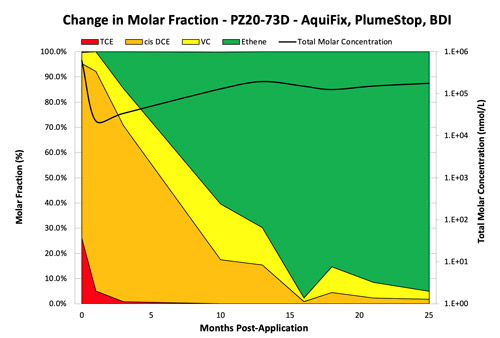 Figure 6. Chlorinated ethene and ethene molar fraction changes at PZ20-73D in AquiFix + PlumeStop pilot test barrier, showing the full conversion of CVOCs to ethene. Molar fractions are plotted on the primary axis and the total molar concentration is shown by the solid line on the secondary axis.
Figure 6. Chlorinated ethene and ethene molar fraction changes at PZ20-73D in AquiFix + PlumeStop pilot test barrier, showing the full conversion of CVOCs to ethene. Molar fractions are plotted on the primary axis and the total molar concentration is shown by the solid line on the secondary axis. Figure 7. DHC and VCR populations at PZ20-73D in AquiFix, PlumeStop, BDI PRB pilot test barrier.
Figure 7. DHC and VCR populations at PZ20-73D in AquiFix, PlumeStop, BDI PRB pilot test barrier.Conclusions
These results suggest extraordinarily effective reductive dechlorination resulting in the almost complete elimination of CVOCs for over two years in an extreme mass flux zone. Further, the observed total organic carbon (TOC) concentrations indicate that AquiFix will continue to supply a hydrogen source and remain effective in facilitating CVOC bioremediation long into the future.
This test shows how AquiFix supports robust CVOC bioremediation to meet the most challenging site conditions, substantially improving the effectiveness and extending the longevity of CVOC bio-barrier treatments.

.webp?height=96&t=1666647051&width=96)

